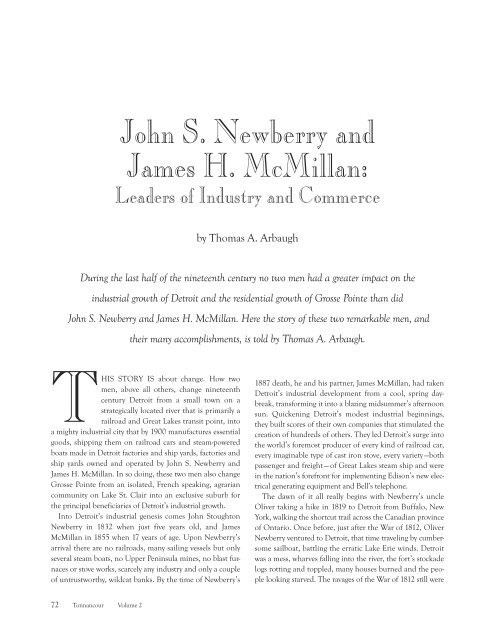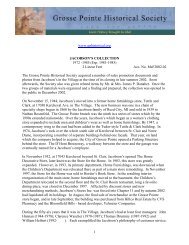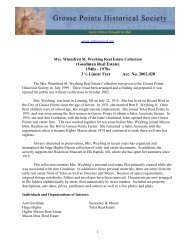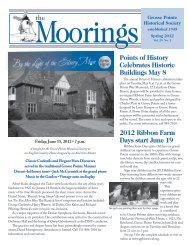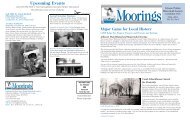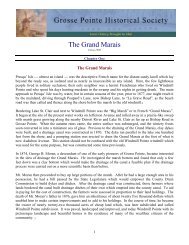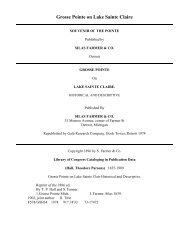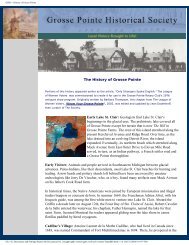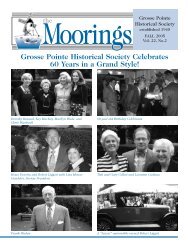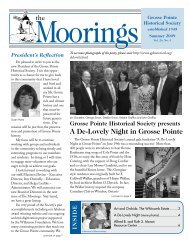John S. Newberry and James H. McMillan - Grosse Pointe Historical ...
John S. Newberry and James H. McMillan - Grosse Pointe Historical ...
John S. Newberry and James H. McMillan - Grosse Pointe Historical ...
Create successful ePaper yourself
Turn your PDF publications into a flip-book with our unique Google optimized e-Paper software.
72 Tonnancour Volume 2<br />
<strong>John</strong> S. <strong>Newberry</strong> <strong>and</strong><br />
<strong>James</strong> H. <strong>McMillan</strong>:<br />
Leaders of Industry <strong>and</strong> Commerce<br />
THIS STORY IS about change. How two<br />
men, above all others, change nineteenth<br />
century Detroit from a small town on a<br />
strategically located river that is primarily a<br />
railroad <strong>and</strong> Great Lakes transit point, into<br />
a mighty industrial city that by 1900 manufactures essential<br />
goods, shipping them on railroad cars <strong>and</strong> steam-powered<br />
boats made in Detroit factories <strong>and</strong> ship yards, factories <strong>and</strong><br />
ship yards owned <strong>and</strong> operated by <strong>John</strong> S. <strong>Newberry</strong> <strong>and</strong><br />
<strong>James</strong> H. <strong>McMillan</strong>. In so doing, these two men also change<br />
<strong>Grosse</strong> <strong>Pointe</strong> from an isolated, French speaking, agrarian<br />
community on Lake St. Clair into an exclusive suburb for<br />
the principal beneficiaries of Detroit’s industrial growth.<br />
Into Detroit’s industrial genesis comes <strong>John</strong> Stoughton<br />
<strong>Newberry</strong> in 1832 when just five years old, <strong>and</strong> <strong>James</strong><br />
<strong>McMillan</strong> in 1855 when 17 years of age. Upon <strong>Newberry</strong>’s<br />
arrival there are no railroads, many sailing vessels but only<br />
several steam boats, no Upper Peninsula mines, no blast furnaces<br />
or stove works, scarcely any industry <strong>and</strong> only a couple<br />
of untrustworthy, wildcat banks. By the time of <strong>Newberry</strong>’s<br />
by Thomas A. Arbaugh<br />
During the last half of the nineteenth century no two men had a greater impact on the<br />
industrial growth of Detroit <strong>and</strong> the residential growth of <strong>Grosse</strong> <strong>Pointe</strong> than did<br />
<strong>John</strong> S. <strong>Newberry</strong> <strong>and</strong> <strong>James</strong> H. <strong>McMillan</strong>. Here the story of these two remarkable men, <strong>and</strong><br />
their many accomplishments, is told by Thomas A. Arbaugh.<br />
1887 death, he <strong>and</strong> his partner, <strong>James</strong> <strong>McMillan</strong>, had taken<br />
Detroit’s industrial development from a cool, spring daybreak,<br />
transforming it into a blazing midsummer’s afternoon<br />
sun. Quickening Detroit’s modest industrial beginnings,<br />
they built scores of their own companies that stimulated the<br />
creation of hundreds of others. They led Detroit’s surge into<br />
the world’s foremost producer of every kind of railroad car,<br />
every imaginable type of cast iron stove, every variety —both<br />
passenger <strong>and</strong> freight — of Great Lakes steam ship <strong>and</strong> were<br />
in the nation’s forefront for implementing Edison’s new electrical<br />
generating equipment <strong>and</strong> Bell’s telephone.<br />
The dawn of it all really begins with <strong>Newberry</strong>’s uncle<br />
Oliver taking a hike in 1819 to Detroit from Buffalo, New<br />
York, walking the shortcut trail across the Canadian province<br />
of Ontario. Once before, just after the War of 1812, Oliver<br />
<strong>Newberry</strong> ventured to Detroit, that time traveling by cumbersome<br />
sailboat, battling the erratic Lake Erie winds. Detroit<br />
was a mess, wharves falling into the river, the fort’s stockade<br />
logs rotting <strong>and</strong> toppled, many houses burned <strong>and</strong> the people<br />
looking starved. The ravages of the War of 1812 still were
JOHN S. NEWBERRY AND JAMES H. MCMILLAN<br />
Volume 2 Tonnancour 73
74 Tonnancour Volume 2<br />
JOHN S. NEWBERRY AND JAMES H. MCMILLAN
in strong evidence <strong>and</strong> he hastily returned to Buffalo.<br />
After the digging of the Erie Canal started on July 4, 1817,<br />
promising freighting rate reductions across New York state<br />
from $32.00 a ton per hundred miles to just one dollar a<br />
ton, Uncle Oliver comes back, first starting a wholesale commission<br />
business, then locating a ship building yard where<br />
Cobo Hall is today. Just two years after the Erie Canal begins<br />
funneling thous<strong>and</strong>s of people west, the steam ship Argo is<br />
built in Detroit. Picking up Erie Canal passengers at Buffalo,<br />
it takes them to Detroit, returning to Buffalo with produce<br />
for the East. By 1837 Detroit’s waterfront is very busy, <strong>and</strong><br />
among the hundreds of boats using its wharves are steamers<br />
built <strong>and</strong> registered in Detroit by Oliver <strong>Newberry</strong>.<br />
Elihu <strong>Newberry</strong> (<strong>John</strong>’s father)<br />
at the urging of his brother, Oliver,<br />
visits Detroit in 1829, evaluating<br />
its prospects. Liking what he sees,<br />
Elihu returns to New York, sells his<br />
farm, <strong>and</strong> comes back to Detroit. But<br />
instead of staying in bustling Detroit,<br />
feeling more comfortable in a rural<br />
setting, <strong>and</strong> using the proceeds from<br />
the farm sale, he buys a wagon <strong>and</strong><br />
sundry goods to sell. Then setting<br />
out to establish a business, he settles<br />
in Romeo, Michigan, about 30 miles<br />
north of Detroit.<br />
There the family thrives (there is a<br />
<strong>Newberry</strong> street in Romeo) allowing<br />
them to build a substantial home <strong>and</strong><br />
enlarge his store. Romeo prospers<br />
so much at the time — in addition to<br />
being a farming center, there also is<br />
a small foundry <strong>and</strong> farm-wagon factory<br />
— the new University of Michigan<br />
establishes a branch campus. Taking<br />
advantage of the local educational opportunity, in 1844<br />
young <strong>John</strong> <strong>Newberry</strong> starts his freshman year studying literature.<br />
After completing his first year in Romeo, his father<br />
sends him on to Ann Arbor for his last three years.<br />
Upon graduating in 1848, <strong>and</strong> at the head of his class,<br />
he disregards his literary degree, which primarily qualifies<br />
him for teaching. Instead, under the influence of his Uncle<br />
Oliver, seeing a better future in business, he hires on with<br />
the Michigan Central Railroad. Working for two years in<br />
their engineering department, he learns engineering management<br />
<strong>and</strong> architecture while laboring to complete the<br />
line from its l<strong>and</strong>locked old terminus in the middle of the<br />
state at Kalamazoo, to the new more economically logical terminus<br />
for midwest transportation at New Buffalo on Lake<br />
Michigan. Once the railroad is completed across Michigan<br />
JOHN S. NEWBERRY AND JAMES H. MCMILLAN<br />
————————— —————————<br />
<strong>John</strong> <strong>Newberry</strong> <strong>and</strong><br />
<strong>James</strong> <strong>McMillan</strong> had<br />
taken Detroit’s<br />
industrial development<br />
from a cool,<br />
spring daybreak,<br />
transforming it into<br />
a blazing midsummer’s<br />
afternoon sun.<br />
————————— —————————<br />
to the lake, it then is profitable to build a railroad across<br />
Ontario, Canada, connecting Detroit by rail directly to both<br />
Boston <strong>and</strong> New York City, thereby strengthening the city’s<br />
important location.<br />
After the railroad is completed <strong>and</strong> wanting to see the<br />
Midwest, <strong>Newberry</strong> takes a year off, <strong>and</strong> traveling mainly by<br />
steamboats, tours the Great Lakes, <strong>and</strong> the Ohio, Mississippi<br />
<strong>and</strong> Missouri Rivers. During those travels, he recognizes the<br />
importance of river <strong>and</strong> lake transportation in addition to<br />
the railroad. Moreover, he is shocked by the number of boat<br />
accidents due to the lack of established st<strong>and</strong>ards <strong>and</strong> regulations.<br />
Consequently there are a number of expensive, extensive<br />
<strong>and</strong> complicated liability suits.<br />
Upon his return <strong>Newberry</strong> ab<strong>and</strong>ons<br />
any more immediate railroad<br />
work in favor of studying maritime law<br />
in the Detroit law offices of Emmons<br />
<strong>and</strong> Van Dyke. In no time he becomes<br />
the acknowledged Midwestern maritime<br />
expert, publishing Reports of<br />
Admiralty Cases in the Several District<br />
Courts of the United States. <strong>Newberry</strong><br />
wins his first important case,<br />
defending Captain Sam Ward, owner<br />
of the Ogdenburg, in his case against<br />
the Atlantic. He proves himself as the<br />
paramount admiralty law litigator in<br />
the Midwest. Establishing his own law<br />
practice, <strong>and</strong> having his office in the<br />
Rotunda Building on the corner of<br />
Larned <strong>and</strong> Griswold streets, in the<br />
heart of Detroit’s growing financial district,<br />
he acquaints himself with all the<br />
important men of Detroit commerce.<br />
Although extremely busy with his<br />
flourishing practice, he is not too busy<br />
to fall in love. While in Buffalo on legal matters, he meets<br />
Harriet Newell Robinson, whom he weds in 1856. A son,<br />
Harrie, is born the same year. Tragically, ten days later, his<br />
wife of less than a year dies. <strong>Newberry</strong> saves all of her personal<br />
possessions <strong>and</strong> wedding gifts as remembrances for Harrie.<br />
Three years later while on business in Clevel<strong>and</strong>, <strong>Newberry</strong><br />
meets Helen Parmelee H<strong>and</strong>y, the daughter of a prominent<br />
banker. Marrying in 1859, they return to Detroit, first living<br />
in a rented house on the four hundred block of the soonto-be-fashionable<br />
East Jefferson Avenue, making that street<br />
the place to live for most of Detroit’s new, post-Civil War,<br />
manufacturing <strong>and</strong> financial class. Two sons, Truman H<strong>and</strong>y<br />
<strong>and</strong> <strong>John</strong> Stoughton Jr., <strong>and</strong> one daughter, Helen Hall, are<br />
born to that union. All three, making excellent use of their<br />
father’s financial legacy, achieve their own successes in late<br />
Volume 2 Tonnancour 75
nineteenth <strong>and</strong> early twentieth century Detroit <strong>and</strong> <strong>Grosse</strong><br />
<strong>Pointe</strong>.<br />
Canadian-born <strong>James</strong> <strong>McMillan</strong> comes from Hamilton,<br />
Ontario, to Detroit in 1855. Although an excellent<br />
scholar <strong>and</strong> qualifying for college, he too, like<br />
<strong>Newberry</strong>, chooses business instead. His father, William,<br />
works for the Great Western Railroad, both as it is being built<br />
through Ontario in the early 1850s connecting the east to<br />
Detroit, <strong>and</strong> in its freight <strong>and</strong> passenger business.<br />
Taking the Great Western, young <strong>McMillan</strong> first sees<br />
Detroit’s busy riverfront with its boats, wharves, warehouses<br />
<strong>and</strong> small factories, from across the river in Windsor. From<br />
there the sailing ship’s spiring masts, spars, <strong>and</strong> web-like<br />
shroud lines resemble a dense forest, while the belching<br />
smoke from the steamboat’s funnels <strong>and</strong> Detroit’s few factories<br />
play hide <strong>and</strong> seek with the sun. Not seeing anything ugly<br />
about it, <strong>McMillan</strong> just sees the economic promise. Carrying<br />
a letter of introduction attesting to his work habits <strong>and</strong> intelligence,<br />
he wastes no time looking for a job.<br />
Stopping first at the hardware store of Christian Buhl <strong>and</strong><br />
Charles DuCharme, he is immediately hired. But the job<br />
lasts only two years as the recession of 1857 forces Buhl <strong>and</strong><br />
DuCharme to retrench, <strong>and</strong> <strong>McMillan</strong> is let go. Because of<br />
76 Tonnancour Volume 2<br />
JOHN S. NEWBERRY AND JAMES H. MCMILLAN<br />
Michigan Car Company’s Works, near the railroad junction in Springwells.<br />
Illustration from Silas Farmer’s History of Detroit <strong>and</strong> Wayne County <strong>and</strong> Early Michigan.<br />
his father’s influence <strong>and</strong> despite the recession, the 20-yearold<br />
soon hires on with the Detroit <strong>and</strong> Milwaukee Railroad.<br />
That railroad is completing its 188 miles of track from<br />
Detroit to Gr<strong>and</strong> Haven, where, to cross Lake Michigan,<br />
steamboat connections are made to Wisconsin. Samuel C.<br />
Ridley, the construction manager, employs <strong>McMillan</strong> as his<br />
materials purchasing agent. Although his two years with Buhl<br />
<strong>and</strong> DuCharme fully acquaint him with Detroit’s industry,<br />
the Detroit <strong>and</strong> Milwaukee job significantly adds to both his<br />
knowledge <strong>and</strong> experience, which becomes very valuable.<br />
<strong>McMillan</strong> performs his job so well that Ridley wants him<br />
for another job in Spain. <strong>McMillan</strong> declines, instead preferring<br />
to marry Mary Wetmore in 1860, the daughter of<br />
Charles Wetmore, a prominent Woodward Avenue merchant.<br />
They have six children.<br />
Detroit, now connected by railroad to both Chicago<br />
<strong>and</strong> the east, is still dependant upon eastern cities<br />
for the manufacture of railroad cars <strong>and</strong> locomotives.<br />
Trying to remedy that situation, Dr. George Russel<br />
establishes in 1853 on Gratiot Avenue a railroad car works,<br />
<strong>and</strong> at Congress <strong>and</strong> Larned streets the Detroit Locomotive<br />
Works, the first such factories east of the Hudson River.<br />
In 1863, the Congress of the United States passes the
Pacific Railroad Act committing the government to subsidize<br />
the construction of transcontinental railroads. That<br />
job, requiring million of tons of steel <strong>and</strong> tens of thous<strong>and</strong>s<br />
of railroad cars, causes <strong>Newberry</strong> <strong>and</strong> <strong>McMillan</strong> — by now<br />
acquaintances through their membership in the Jefferson<br />
Avenue Presbyterian Church — to act quickly.<br />
When Dr. Russel becomes ill, two of his employees,<br />
George Eaton <strong>and</strong> Edward Dean, lease his new Croghan<br />
Street shops. Then, because of expected sales increases, they<br />
buy an additional seven acres at Fourth Street <strong>and</strong> Larned,<br />
establishing there another car company, the Michigan Car<br />
Works. Because Eaton <strong>and</strong> Dean need additional financing,<br />
they join with the eager <strong>Newberry</strong> <strong>and</strong> <strong>McMillan</strong>. In addition<br />
to his own significant resources,<br />
<strong>Newberry</strong> is respected enough in<br />
Detroit’s banking circles to get additional<br />
money.<br />
Of the two, <strong>McMillan</strong> is the more<br />
outgoing, willing to take chances,<br />
able to meet railroad barons <strong>and</strong><br />
secure contracts. Initially <strong>Newberry</strong>,<br />
the more experienced businessman,<br />
draws up better contracts for the new<br />
company. But, as their companies<br />
prosper through the 1870s <strong>and</strong> 1880s<br />
<strong>Newberry</strong> becomes more sanguine<br />
<strong>and</strong> conservative.<br />
Shortly after the Civil War ends,<br />
they secure a contract from the new<br />
Union Pacific Railroad to build 700<br />
freight cars. That railroad, taking<br />
advantage of the generous government<br />
l<strong>and</strong> <strong>and</strong> cash construction subsidies,<br />
builds tracks westward from Omaha, Nebraska. They are hoping<br />
to hook-up somewhere out West with the new Central<br />
Pacific Railroad <strong>and</strong> build tracks eastward from California.<br />
With the untimely death of George Eaton, <strong>and</strong> his<br />
widow not caring about continuing in the business <strong>and</strong> willing<br />
to sell her stock, <strong>Newberry</strong> <strong>and</strong> <strong>McMillan</strong>’s combined<br />
7,200 shares now greatly outnumber Dean’s 3,600 shares.<br />
Consequently they rename the company <strong>and</strong> officially<br />
incorporate it in the state of Michigan as the Michigan Car<br />
Company.<br />
Acting entrepreneurial, <strong>Newberry</strong> <strong>and</strong> <strong>McMillan</strong> send<br />
<strong>McMillan</strong>’s brother, Hugh, to St. Louis, to establish the<br />
Missouri Car Company. As Detroit is becoming a center<br />
for railroading in the Great Lakes region, they fully expect<br />
St. Louis to do the same for the Mississippi Valley as well as<br />
become an entrepôt for goods going west <strong>and</strong> coming east.<br />
Soon that company does an annual $1,500,000 worth of business<br />
(at this time a basic freight car sells for $450). Moreover,<br />
JOHN S. NEWBERRY AND JAMES H. MCMILLAN<br />
————————— —————————<br />
Of the two,<br />
<strong>McMillan</strong> is the<br />
more outgoing, willing<br />
to take chances;<br />
<strong>Newberry</strong>, the more<br />
experienced, sanguine,<br />
<strong>and</strong> conservative.<br />
————————— —————————<br />
fully recognizing the importance of the Canadian connection,<br />
they incorporate the Ontario Car Company in London,<br />
Ontario, which makes cars with an eight-foot gauge — as compared<br />
to the four-foot-eight-<strong>and</strong>-a-half inch gauge for American<br />
cars — for all railroads operating in that country.<br />
By 1870, their impact on Detroit is evident. Industrial<br />
employment increases from 1,363 jobs in 1860 to 10,612,<br />
<strong>and</strong> the value of finished product increases from $2.1 million<br />
to $21.8 million. In 1873, <strong>Newberry</strong> <strong>and</strong> <strong>McMillan</strong><br />
alone clear a little more than one million dollars in profits.<br />
Meaning to take control of the entire railroad car manufacturing<br />
process in Detroit, in 1865 <strong>Newberry</strong> <strong>and</strong> <strong>McMillan</strong><br />
incorporate the Detroit Car Wheel Company, capitalized at<br />
$250,000. At that time, poor wheels<br />
caused most railroad accidents.<br />
Determined to establish a reputation<br />
for making the best — although much<br />
more expensive — they insist upon<br />
using wrought iron which makes<br />
the best wheels. Initially Detroit Car<br />
Wheel produces just 20 wheels a day<br />
but within two years with 30 men<br />
working in the foundry, they begin<br />
producing three times that amount.<br />
Not everything goes their way,<br />
however. <strong>Newberry</strong> <strong>and</strong> <strong>McMillan</strong><br />
are forced out of the passenger car<br />
segment of the railroad car manufacturing<br />
business when George M. Pullman<br />
comes to Detroit in 1868. The<br />
king of the sleeping car <strong>and</strong> the ordinary<br />
passenger car, Pullman buys the<br />
ab<strong>and</strong>oned Detroit Car Works of Dr.<br />
Russel at Croghan <strong>and</strong> Dequindre. Pullman reorganizes it<br />
as the Detroit Car <strong>and</strong> Manufacturing Works Company<br />
(located just east of the modern-day Chrysler Freeway, in<br />
downtown Detroit). Several years after the Civil War ends,<br />
Detroit rapidly starts leading the nation in railroad car<br />
building. Pullman buys some of his needed components<br />
from <strong>Newberry</strong> <strong>and</strong> <strong>McMillan</strong>.<br />
With this industrial expansion, Detroit manufacturers<br />
need more steam engines to power their factories <strong>and</strong> other<br />
essential items made from iron. Fulfilling those requirements,<br />
<strong>Newberry</strong> <strong>and</strong> <strong>McMillan</strong> establish in 1867 the Fulton<br />
Iron <strong>and</strong> Engine Works on Brush Street. There they build<br />
steam engines, industrial anvils <strong>and</strong> vises, architectural iron<br />
works, mill work <strong>and</strong> many parts for railroad cars <strong>and</strong> locomotives.<br />
So much western grain <strong>and</strong> Michigan lumber begins funneling<br />
through Detroit that in 1868 <strong>Newberry</strong> <strong>and</strong> <strong>McMillan</strong><br />
incorporate the Detroit Elevator Company <strong>and</strong> the Detroit<br />
Volume 2 Tonnancour 77
Residence of <strong>John</strong> S. <strong>Newberry</strong>, 1363 East Jefferson Avenue.<br />
Built in 1875. Illustration from Silas Farmer’s History of<br />
Detroit <strong>and</strong> Wayne County <strong>and</strong> Early Michigan.<br />
River Lumber Company. Eventually the elevator company<br />
employs 30 men servicing grain silos both in Detroit <strong>and</strong><br />
Gr<strong>and</strong> Haven on Lake Michigan. The silos, 135 feet high<br />
<strong>and</strong> having capacities of over one million bushels, are located<br />
on the water front close by the Detroit <strong>and</strong> Milwaukee<br />
Railroad depot located at the foot of Brush Street (the present-day<br />
site of the Renaissance Center).<br />
In addition to greatly stimulating the growth of new<br />
industries in Detroit, <strong>Newberry</strong> <strong>and</strong> <strong>McMillan</strong> also<br />
influence the creators of those new industries to build<br />
their year around residences on East Jefferson <strong>and</strong> summer<br />
homes in “The <strong>Pointe</strong>” as it was styled 120 years ago.<br />
A few of those joining <strong>Newberry</strong> <strong>and</strong> <strong>McMillan</strong> building<br />
homes on East Jefferson are: George Hendrie, president of<br />
the Detroit Car <strong>and</strong> Marshall Car Companies <strong>and</strong> secretary<br />
of the Detroit City Railroad Company; William B. Wesson,<br />
president of Hargreaves Manufacturing Company <strong>and</strong> of the<br />
Wayne County Savings Bank; Francis Palms, president of the<br />
Michigan Stove Company, the Peoples Savings Bank, <strong>and</strong> the<br />
Palms Gold Mining Company; <strong>and</strong> William K. Muir, president<br />
of Eureka Iron Company, the Cloud Manufacturing<br />
Company, the Aikman Automatic Car Coupler Company,<br />
the Northwestern Rolling Stock Company, <strong>and</strong> of Detroit<br />
Car Loan Company.<br />
<strong>Newberry</strong> <strong>and</strong> <strong>McMillan</strong> pay a thous<strong>and</strong> dollars an acre to<br />
buy <strong>Grosse</strong> <strong>Pointe</strong>’s French strip farms. In 1875 they build<br />
their mirror-image, three-story “cottages” named “Lake<br />
Terrace,” that turn the <strong>Pointe</strong> into an exclusive summer colony<br />
for Detroit’s nouveau riche.<br />
Some have preceded <strong>Newberry</strong> <strong>and</strong> <strong>McMillan</strong>, <strong>and</strong> are<br />
already enjoying Lake St. Clair’s splendid scenery, cooling<br />
breezes, abundance of white fish, pickerel, trout, muskel-<br />
78 Tonnancour Volume 2<br />
JOHN S. NEWBERRY AND JAMES H. MCMILLAN<br />
lunge <strong>and</strong> sturgeon, sailing its choppy, blue-green waters,<br />
<strong>and</strong> relishing a playful summer’s respite from Detroit’s ever<br />
increasing industrial hustle <strong>and</strong> bustle. They are Theodore<br />
H. Hinchman, a respected Detroit merchant; D. Bethune<br />
Duffield, a lawyer; Edmund Askin Brush, owner of Detroit<br />
real estate; Dr. Morse Stewart, one of Detroit’s most<br />
respected physicians; Dr. Isaac Smith, who came to <strong>Grosse</strong><br />
<strong>Pointe</strong> from California’s gold fields in the early 1850s; G. V.<br />
N. Lothrop, a railroad lawyer; <strong>and</strong> Dudley B. Woodbridge,<br />
son of a Michigan governor <strong>and</strong> manager of a farm <strong>and</strong><br />
Detroit real estate.<br />
Some of those following <strong>Newberry</strong> <strong>and</strong> <strong>McMillan</strong> building<br />
summer residences are: T. P. Hall, who built “Tonnancour”<br />
in 1880, a commodities broker <strong>and</strong> grain merchant;<br />
<strong>John</strong> B. Moran who built “Bellevue” in 1882, president of<br />
the Peninsula Stove Company, <strong>and</strong> Detroit Electric Light<br />
<strong>and</strong> Power; Hugh <strong>McMillan</strong>, who built on Cloverleigh in<br />
1882, secretary <strong>and</strong> treasurer of the Telephone <strong>and</strong> Telegraph<br />
Construction Company <strong>and</strong> Michigan Bell Telephone,<br />
president of the Commercial National Bank <strong>and</strong> of<br />
the National Electric Traction Company; H. B. Ledyard who<br />
also built on Cloverleigh in 1882, president of the Michigan<br />
Central Railroad; W. K. Muir who built “Otskita” in 1882; W.<br />
A. McGraw who built the “Poplars” in 1884, a successful real<br />
estate developer; <strong>and</strong> Joseph Berry who built “Edgemere” in<br />
1882, a co-owner of Berry Brothers Paint <strong>and</strong> Varnish, president<br />
of Detroit Linseed Oil Company, <strong>and</strong> of Combination<br />
Gas Machine Company.<br />
Getting to the <strong>Pointe</strong> is a pleasurable pastime. If <strong>Newberry</strong>,<br />
<strong>McMillan</strong> <strong>and</strong> their families are in town — living in neighboring<br />
residences on East Jefferson Avenue — <strong>and</strong> wishing to go<br />
to the <strong>Pointe</strong>, they order their carriages to take them the several<br />
blocks to their adjacent private yacht houses located on<br />
Atwater Street, to board their steam yacht. Depending upon<br />
their pleasure, the trip can take several hours. The men<br />
Residence of <strong>James</strong> H. <strong>McMillan</strong>, 1411 East Jefferson<br />
Avenue. Built 1873-80. Illustration from Silas Farmer’s<br />
History of Detroit <strong>and</strong> Wayne County <strong>and</strong> Early Michigan.
dress in white-duck trousers <strong>and</strong> blue blazers; the women in<br />
light pastel frocks reaching to their ankles, carrying parasols<br />
shielding themselves from the hot sun. Gliding past Belle Isle<br />
they admire the isl<strong>and</strong>’s development into a beautiful park<br />
under the leadership of <strong>James</strong> <strong>McMillan</strong>, probably evaluate<br />
the progress of the new Detroit water works trying to meet<br />
the needs of the growing population, strain to see the racing<br />
at the <strong>Grosse</strong> <strong>Pointe</strong> Race Course, <strong>and</strong> then try estimating<br />
how many people are enjoying themselves at the new park<br />
on Windmill <strong>Pointe</strong>. All the while bantering with those on<br />
sailboats playfully challenging them to race.<br />
Upon arriving at the <strong>Pointe</strong> they l<strong>and</strong> at a dock — jointly<br />
built with Alfred E. Brush — extending well into the Lake.<br />
Perhaps already moored there are Brush’s yacht, the Lillie,<br />
<strong>and</strong> another, the Leila, mutually operated by many of the<br />
other summer colonists. Their summer carriages are called<br />
for <strong>and</strong> if they wish, before going to “Lake Terrace,” they<br />
might take a drive on the Lake Shore Road enjoying the<br />
beautiful homes <strong>and</strong> admiring the l<strong>and</strong>scape architecture.<br />
The top of the carriage is down <strong>and</strong> they fancy the different<br />
trees from Japan, South America <strong>and</strong> from all over the<br />
JOHN S. NEWBERRY AND JAMES H. MCMILLAN<br />
“Lake Terrace.” The summer cottages of <strong>Newberry</strong> <strong>and</strong> <strong>McMillan</strong>, Lake Shore Road, <strong>Grosse</strong> <strong>Pointe</strong>. Built in 1875.<br />
Photo courtesy of the Burton <strong>Historical</strong> Collection, Detroit Public Library.<br />
United States both shading the drives to the summer homes<br />
<strong>and</strong> being artfully placed on the grounds to look natural. The<br />
musical sounds of all the birds singing in those trees entertain<br />
them. They watch the summer help — who are beginning<br />
to live year-around in the <strong>Pointe</strong>— manicure the lawns.<br />
When passing the old Vernier house with its double porch,<br />
still surrounded by orchards, they probably gossip about who<br />
might buy the place. They are charmed by the old curmudgeon<br />
Ferdin<strong>and</strong> Charles Rivard, still the largest French l<strong>and</strong><br />
owner in the <strong>Pointe</strong>, if he happens by challenging them to<br />
race — his love of horse racing is legend. Proceeding past the<br />
Hamilton Park built by <strong>James</strong> <strong>McMillan</strong> for racing <strong>and</strong> exercising<br />
horses, he especially looks to see who of his friends are<br />
using it.<br />
Upon coming to the Protestant Church, — reorganized <strong>and</strong><br />
enlarged by <strong>Newberry</strong> <strong>and</strong> <strong>McMillan</strong> for the exp<strong>and</strong>ing summer<br />
population — they wonder who Sunday’s guest preacher<br />
might be. Then on to the Claireview Stock farm, owned<br />
<strong>and</strong> operated by George S. Davis, the executive officer of<br />
the Parke, Davis Pharmaceutical Company. The farm has 28<br />
buildings, a blacksmith shop, 60 st<strong>and</strong>ard bred horses, 30<br />
Volume 2 Tonnancour 79
ood mares belonging to others, a herd of Jersey cows, all<br />
well tended by 25 employees. And, before returning to “Lake<br />
Terrace,” they fulfill one of their special social obligations<br />
by inspecting a summer convalescent home kept for Detroit<br />
children.<br />
Once <strong>Newberry</strong> <strong>and</strong> <strong>McMillan</strong> establish their domination<br />
of the railroad rolling stock industry, thereby<br />
creating a firm financial foundation, they quickly<br />
move to dominate the ship building <strong>and</strong> steamboat transportation<br />
businesses. The Detroit Dry Dock Company located<br />
at the foot of Orleans at Atwater Street is purchased in 1872,<br />
capitalized at $400,000 with <strong>James</strong> <strong>McMillan</strong> president. In<br />
1879 they purchase the Clark Dry Dock Company located at<br />
the foot of Clark Street in Springwells<br />
not far from their West Detroit,<br />
Michigan Car Company plant. To<br />
supply engines for their boats they buy<br />
the Dry Dock Engine Works in 1886.<br />
Then a third ship building company<br />
is acquired, the Detroit Boat Works<br />
located on Atwater Street, where<br />
<strong>McMillan</strong> immediately orders a new<br />
steam yacht, the Idler, equipped with<br />
an electrical generator. Making their<br />
move in 1882 into the steam transit<br />
business, they buy into the Detroit<br />
<strong>and</strong> Clevel<strong>and</strong> Steam Navigation<br />
Company, making <strong>McMillan</strong> vice<br />
president. They also buy the Detroit<br />
Transit Company with <strong>McMillan</strong> as<br />
president; the Detroit Navigation<br />
Company is purchased, with<br />
<strong>Newberry</strong> vice president, <strong>and</strong> finally<br />
Star Lines Steamers is purchased, with <strong>McMillan</strong> president<br />
<strong>and</strong> <strong>Newberry</strong> vice president.<br />
There is not a business to which they were not attracted. In<br />
1873 they incorporate the Detroit Seed Company that competes<br />
with Dexter Mason Ferry’s seed company. They specialize<br />
in garden seeds, flower seeds, field seeds, trees, plants<br />
<strong>and</strong> dried flowers. About a quarter mile from the city limits<br />
bordering Michigan Avenue they establish their seed farm<br />
<strong>and</strong> trial gardens. Although the Detroit Seed Company does<br />
well, making plenty of money, D. M. Ferry <strong>and</strong> Company<br />
absorbs it in 1880 —obviously with <strong>McMillan</strong>’s blessings as<br />
he becomes vice president of the new company, remaining<br />
so until his death in 1902. So profitable is the new company<br />
that at the time of <strong>McMillan</strong>’s death each share of stock is<br />
worth over $5,000.<br />
No new invention escapes their financial eye. One year<br />
after Alex<strong>and</strong>er Graham Bell demonstrates the practical-<br />
80 Tonnancour Volume 2<br />
JOHN S. NEWBERRY AND JAMES H. MCMILLAN<br />
————————— —————————<br />
There is not a<br />
business to which<br />
they were not<br />
attracted. . . .<br />
Occasionally<br />
<strong>Newberry</strong> <strong>and</strong><br />
<strong>McMillan</strong>’s ambitions<br />
get the best of them.<br />
————————— —————————<br />
ity of his telephone at the 1876 Philadelphia Centennial,<br />
The Telephone <strong>and</strong> Telegraph Construction Company is<br />
incorporated at $500,000 with Hugh <strong>McMillan</strong> secretary.<br />
Not satisfied with merely erecting poles <strong>and</strong> stringing wire,<br />
Michigan Bell Telephone is incorporated in 1881 with Hugh<br />
<strong>McMillan</strong> as both secretary <strong>and</strong> treasurer. Believing it’s time<br />
to take active control of the new telephone business, <strong>James</strong><br />
<strong>McMillan</strong> becomes president of the Michigan Telephone<br />
Company with brother Hugh still secretary <strong>and</strong> treasurer.<br />
In 1882, when Thomas Edison demonstrates he can generate<br />
a continuous flow of electricity to power his new light<br />
bulb <strong>and</strong> other electrically powered inventions, <strong>McMillan</strong><br />
incorporates the Edison Electric company. To supply power<br />
for the city’s new street lights, <strong>McMillan</strong> incorporates the<br />
Electrical Accumulator <strong>and</strong> Lighting<br />
Company with his son, William C.<br />
<strong>McMillan</strong>, as secretary.<br />
Occasionally <strong>Newberry</strong> <strong>and</strong><br />
<strong>McMillan</strong>’s ambitions get the best<br />
of them. Believing there is a need<br />
for additional office space due to<br />
Detroit’s rapid growth, they complete<br />
two office building complexes in 1879:<br />
the <strong>Newberry</strong> <strong>and</strong> <strong>McMillan</strong> Building<br />
at the corner of Griswold <strong>and</strong> Larned<br />
streets in the heart of Detroit’s “Wall<br />
Street,” <strong>and</strong> in the second block north<br />
of Jefferson Avenue on Woodward a<br />
much bigger office block comprising<br />
four adjoining addresses. But they<br />
misjudge the need for office space,<br />
<strong>and</strong> new rentals come in very slowly.<br />
Hoping then to attract occupants,<br />
they lower their rents <strong>and</strong> actively<br />
recruit tenants from other office buildings. One l<strong>and</strong>lord losing<br />
his tenants to <strong>Newberry</strong> <strong>and</strong> <strong>McMillan</strong> is Christian Buhl.<br />
That was a serious mistake, for Buhl was not a man to fool<br />
with.<br />
In addition to his hardware store <strong>and</strong> a wholesale fur<br />
business, Buhl owns or is a majority stock holder in: the<br />
Second National Bank, of which he is a vice president; the<br />
Peninsula Stove Company, of which he is the treasurer;<br />
the Detroit Copper <strong>and</strong> Brass Rolling Mills, of which he<br />
is president; <strong>and</strong> the Buhl Iron Works, of which he is also<br />
president. As revenge, Buhl finances Col. Frank Hecker<br />
<strong>and</strong> Charles Freer’s Peninsular Car Company with his son,<br />
Theodore Buhl, as president to safeguard his father’s interests.<br />
They buy Hiram Walker’s buildings on Woodbridge<br />
near Joseph Campau streets for their factory. The investors<br />
are Buhl, Hecker, <strong>and</strong> Freer. Freer’s $6,000 note is endorsed<br />
by Russell Alger <strong>and</strong> Hiram Walker. Although the 1880s is a
very prosperous decade with great dem<strong>and</strong> for railroad cars,<br />
Hecker <strong>and</strong> Freer are outst<strong>and</strong>ing managers selling record<br />
numbers of cars. Within just five years Hecker <strong>and</strong> Freer are<br />
able to buy out Buhl <strong>and</strong> Walker. Then for $50,000 each<br />
they take on Russell Alger, <strong>James</strong> Frederick Joy <strong>and</strong> Allen<br />
Sheldon as their new partners. They move their factory to<br />
the Milwaukee Junction, <strong>and</strong> the new facility becomes so<br />
profitable that within just three more years Hecker <strong>and</strong> Freer<br />
can now buy out Alger, Joy <strong>and</strong> Sheldon for $150,000 each,<br />
keeping a 33-1/3% dividend for themselves. Buhl gets his<br />
revenge as Hecker <strong>and</strong> Freer become more than just “mere”<br />
competitors for <strong>Newberry</strong> <strong>and</strong> <strong>McMillan</strong>.<br />
By 1880 <strong>Newberry</strong> is suffering from Brights disease,<br />
an ailment of the kidneys. Undoubtedly preparing<br />
for his death, he begins keeping yearly trial balances<br />
of his net worth. In 1880 his investments total $2.5 million<br />
<strong>and</strong> his wife’s, $281,840; in 1881, <strong>Newberry</strong>’s worth is $2.9<br />
million with his wife’s $356,840; in 1885, $3.8 million (no<br />
separate figures for his wife); in 1886, $4.5 million (again no<br />
figures for his wife). With death approaching he also begins<br />
suffering from bronchial asthma. Refusing to confine himself<br />
to bed, he insists upon sitting in his chair so he can look<br />
out his bay window. On November 25, 1886 he signs his will<br />
making the comment, “That will make a nice present for the<br />
JOHN S. NEWBERRY AND JAMES H. MCMILLAN<br />
Docks <strong>and</strong> repair yard of the Detroit Dry Dock Company, foot of Orleans Street.<br />
Illustration from Silas Farmer’s History of Detroit <strong>and</strong> Wayne County <strong>and</strong> Early Michigan.<br />
boys.”<br />
While sitting in his chair, <strong>Newberry</strong> passes away on<br />
January 2, 1887. Servants rush to <strong>James</strong> <strong>McMillan</strong>’s house<br />
several doors away, but he can not revive his beloved <strong>and</strong><br />
trusted partner of many years.<br />
His funeral is the occasion for many tributes, but the one<br />
offered by his old Romeo friend <strong>and</strong> university classmate is<br />
probably the best. Judge J. Logan Chipman eulogizes. “With<br />
Mr. <strong>Newberry</strong>, as with all great men, there was indomitable<br />
will, energy, the great iron power that characterized his whole<br />
life.” His estate is worth approximately $4.5 million, with<br />
investments in more than fifty different companies. To charitable<br />
organizations he leaves $650,000.<br />
Perhaps getting a little tired of making money, perhaps<br />
missing his long-time partner, <strong>McMillan</strong> turns to politics in<br />
the late 1880s, getting elected to the United States Senate in<br />
1889.<br />
Upon arriving at the nation’s capital, he is dismayed at<br />
its lack of beauty, style <strong>and</strong> grace. To correct that defect he<br />
gets himself elected as chairman of the District of Columbia<br />
Committee, <strong>and</strong> calls for a review of Pierre L’Enfant’s<br />
original plans. Using the expertise gained as chairman of<br />
the Detroit committee overseeing the development of Belle<br />
Isle, <strong>McMillan</strong> immediately gets increased Congressional<br />
appropriations <strong>and</strong> hires professionals to make plans. The<br />
Volume 2 Tonnancour 81
first change is the removal of railroad tracks <strong>and</strong> the railroad<br />
depot from the Mall, <strong>and</strong> rerouting trains into the city<br />
through a newly-dug tunnel into the Union Station. He has<br />
the White House enlarged, <strong>and</strong> groups new federal buildings<br />
into what is now called the Federal Triangle. Using<br />
European models, he supervises the widening of avenues,<br />
the expansion of the old <strong>and</strong> creation of new parks, <strong>and</strong> the<br />
building of Memorial Bridge to Arlington, Virginia.<br />
Being exceptionally busy as a U.S. Senator <strong>and</strong> wanting<br />
to curtail his business activities, he employs the aphorism,<br />
“If you cannot beat them, join them.” To Hecker <strong>and</strong> Freer,<br />
<strong>McMillan</strong> proposes a combination of their railroad car companies.<br />
They agree <strong>and</strong> five companies are consolidated in<br />
1892 with a capital stock of $8 million <strong>and</strong> $2 million in<br />
bonds, under the name of The Michigan-Peninsular Car<br />
Company.<br />
To assuage the fears of the new stock <strong>and</strong> bond holders,<br />
<strong>McMillan</strong> reassures them he will stay on for the next five<br />
years helping to guide the new company. But, the very next<br />
year a severe economic depression forces 5,000 companies<br />
into bankruptcy <strong>and</strong> drives over 600 railroads out of business,<br />
putting more than a million workers out of a job. The<br />
effect on the new Michigan-Peninsular Company is disastrous.<br />
The company waters its stock, hoping new orders can<br />
justify the practice. Instead, new orders never materialize <strong>and</strong><br />
old orders are cancelled. The consequence is that the actual<br />
value of the stock <strong>and</strong> good will is reduced to $2 million.<br />
The preferred stock holders are upset. They hold $5 million<br />
worth of 8% cumulative preferred stock, which they<br />
bought upon <strong>McMillan</strong>’s strong recommendation. Because<br />
of the watered stock, fixed costs are too high, putting the<br />
new company at a competitive disadvantage. The interest on<br />
the bonds amounts to $100,000 a year. In 1894 they lack the<br />
$63,976 necessary to make the payments. Earnings in 1896<br />
are only $35,000, not enough to meet fixed costs.<br />
To extricate the new company from its morass of financial<br />
difficulties, <strong>McMillan</strong> returns to Detroit from Washington,<br />
D.C. <strong>and</strong> begins organizing the American Car <strong>and</strong> Foundry<br />
Company. The Chairman of the Board is <strong>James</strong> <strong>McMillan</strong>’s<br />
eldest son, William C. <strong>McMillan</strong>. The company is capitalized<br />
at $30 million worth of 7% non-cumulative preferred stock<br />
<strong>and</strong> $30 million of common stock. <strong>James</strong> <strong>McMillan</strong> holds a<br />
considerable amount of stock in the new company, hoping<br />
he can live out the remaining years of his life on substantial<br />
dividends from that stock.<br />
Such is not to be the case, for just three years after the<br />
formation of the American Car <strong>and</strong> Foundry company,<br />
<strong>McMillan</strong> dies on August 10, 1902, just past his sixty-fourth<br />
birthday. He suffers a heart attack at his new summer home,<br />
Eagle Head at Manchester-By-The-Sea, Massachusetts. Henry<br />
B. Ledyard, president of the Michigan Central, sends his pri-<br />
82 Tonnancour Volume 2<br />
JOHN S. NEWBERRY AND JAMES H. MCMILLAN<br />
vate railroad car to transport <strong>McMillan</strong> <strong>and</strong> his family back<br />
to Detroit. As Russell A. Alger described him, “He had a<br />
will, <strong>and</strong> a purpose; he exercised the first <strong>and</strong> followed <strong>and</strong><br />
conquered that which he sought.”<br />
Years later, when a new generation of industrialists<br />
began manufacturing automobiles in Detroit <strong>and</strong><br />
desired both an economic climate <strong>and</strong> an elegant<br />
area in which to live, <strong>Newberry</strong> <strong>and</strong> <strong>McMillan</strong> had paved the<br />
way by creating foundries, shops, factories, a trained work<br />
force, plenty of capital <strong>and</strong> a graceful, very desirable, <strong>Grosse</strong><br />
<strong>Pointe</strong>.<br />
————————— ——————————<br />
For over thirty years Thomas A. Arbaugh has been a<br />
member of the faculty at Macomb Community College. He<br />
is presently a professor teaching American History <strong>and</strong> the<br />
History of Technology. His teaching <strong>and</strong> study of the industrial<br />
history of Detroit led to the research <strong>and</strong> writing of this<br />
article. Mr. Arbaugh is a long-time resident of <strong>Grosse</strong> <strong>Pointe</strong><br />
Park.<br />
————————— ——————————<br />
ILLUSTRATION CREDITS: Portraits of <strong>John</strong> S. <strong>Newberry</strong><br />
(page 73) <strong>and</strong> <strong>James</strong> H. <strong>McMillan</strong> (page 74) from<br />
Compendium of History <strong>and</strong> Biography of the City of<br />
Detroit.


